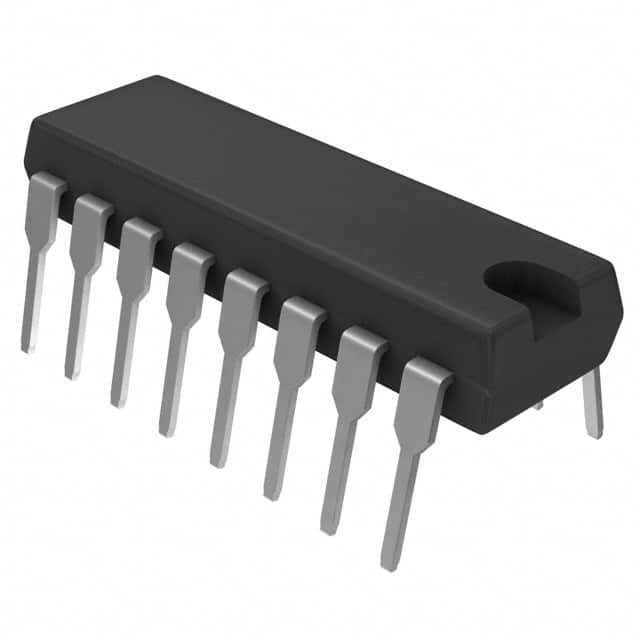Zie specificaties voor productdetails.

MM74C925N
Product Overview
Category
The MM74C925N belongs to the category of integrated circuits (ICs) and specifically falls under the family of digital ICs.
Use
This product is commonly used for digital counter applications, particularly in electronic devices and systems where counting and display functions are required.
Characteristics
- The MM74C925N is known for its high-speed operation and low power consumption, making it suitable for various battery-powered or energy-efficient electronic devices.
- It features a compact design and compatibility with a wide range of digital systems, making it versatile for different applications.
Package
The MM74C925N is typically available in a dual in-line package (DIP), which facilitates easy installation on printed circuit boards (PCBs).
Essence
The essence of this product lies in its ability to accurately count and display digital signals, providing a fundamental function in electronic systems.
Packaging/Quantity
It is commonly packaged in tubes or trays, with quantities varying based on the supplier and customer requirements.
Specifications
- Supply Voltage: 5V
- Maximum Clock Frequency: 30MHz
- Number of Counting Stages: 4
- Operating Temperature Range: -40°C to 85°C
- Output Drive Capability: 10 TTL Loads
Detailed Pin Configuration
The MM74C925N has 16 pins, with each pin serving specific input/output and control functions. The detailed pin configuration is as follows: 1. VCC 2. GND 3. Clock Input (CLK) 4. Reset Input (RST) 5. Carry Output (CY) 6. BCD Output A (QA) 7. BCD Output B (QB) 8. BCD Output C (QC) 9. BCD Output D (QD) 10. BCD Input A (A) 11. BCD Input B (B) 12. BCD Input C (C) 13. BCD Input D (D) 14. Lamp Test Input (LT) 15. Blanking Input (BL) 16. Display Enable (DE)
Functional Features
- BCD Decade Counter: The MM74C925N operates as a binary-coded decimal (BCD) decade counter, allowing it to count from 0 to 9 and reset back to 0.
- Display Driver: It includes built-in display driver capabilities, enabling direct interfacing with common cathode or common anode displays.
- Cascadable Design: Multiple MM74C925N units can be cascaded to create larger counting ranges, expanding its application flexibility.
Advantages and Disadvantages
Advantages
- Low Power Consumption: The IC's efficient power usage makes it suitable for battery-operated devices.
- High-Speed Operation: Its capability to handle high clock frequencies enhances its performance in time-critical applications.
- Versatile Interface: The built-in display driver simplifies the connection to various types of displays.
Disadvantages
- Limited Counting Range: The 4-stage counter may not be sufficient for applications requiring extensive counting capabilities.
- External Components Required: Additional components may be needed for certain display configurations, increasing system complexity.
Working Principles
The MM74C925N operates by receiving clock pulses at the CLK input, incrementing the count based on the input signal. When the count reaches 9, the next clock pulse resets the count to 0 and activates the carry output (CY). The BCD outputs provide the corresponding binary-coded decimal representation of the count, facilitating direct display connections.
Detailed Application Field Plans
The MM74C925N finds applications in various electronic systems, including: - Digital Timers: Utilized for timekeeping and countdown functions in appliances and industrial equipment. - Frequency Dividers: Employed in signal processing circuits to divide input frequencies for specific operations. - Industrial Counters: Integrated into production line machinery for tracking and displaying production counts.
Detailed and Complete Alternative Models
- CD4017: A popular CMOS decade counter with 10 output stages, offering a wider counting range.
- SN74LS192: A synchronous 4-bit up/down decade counter with parallel load capability, suitable for bidirectional counting applications.
In conclusion, the MM74C925N serves as a reliable and efficient digital counter IC, catering to diverse applications that require accurate counting and display functionalities within electronic systems.
Word Count: 611
Noem 10 veelgestelde vragen en antwoorden met betrekking tot de toepassing van MM74C925N in technische oplossingen
What is MM74C925N?
- MM74C925N is a 4-digit, BCD counter with built-in input logic for seven-segment display drivers.
How many digits can MM74C925N count up to?
- MM74C925N can count up to 9999 in BCD format.
What is the maximum clock frequency supported by MM74C925N?
- The maximum clock frequency supported by MM74C925N is typically 2.5MHz.
Can MM74C925N directly drive a seven-segment display?
- Yes, MM74C925N has built-in input logic for driving common-cathode or common-anode seven-segment displays.
What are the typical applications of MM74C925N?
- MM74C925N is commonly used in digital counters, industrial control systems, and electronic test equipment.
Does MM74C925N require external components for operation?
- MM74C925N requires minimal external components for operation, such as resistors for current limiting and capacitors for noise filtering.
What is the supply voltage range for MM74C925N?
- The supply voltage range for MM74C925N is typically 3V to 15V.
Is MM74C925N suitable for battery-powered applications?
- Yes, MM74C925N's low power consumption makes it suitable for battery-powered applications.
Can MM74C925N be cascaded to count beyond 9999?
- Yes, multiple MM74C925N ICs can be cascaded to count beyond 9999 by connecting the carry-out of one IC to the clock input of the next.
Are there any precautions to consider when using MM74C925N?
- It's important to ensure proper decoupling and bypassing of the power supply to minimize noise and voltage fluctuations. Additionally, care should be taken to avoid exceeding the maximum ratings specified in the datasheet.

